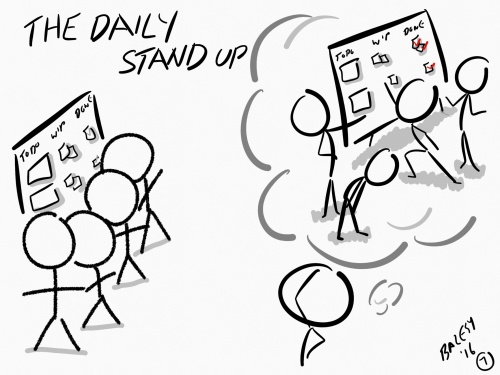Daily Scrum
The Daily Scrums are a daily 15 minute time-boxed event to provide an opportunity for the Development Team to inspect their progress towards the Sprint Goal. The event is conducted by the Development Team and is specifically for them to coordinate and synchronise their activities. Since November 2017, the Scrum Guide indicates that the Daily Scrum format is chosen by the Development Team, and may be conversation based or may be question based.
The Scrum Guide provides an example of a question based approach to the Daily Scrum to explain:
- “What did I do yesterday that helped the Development Team meet the Sprint Goal?
- What will I do today to help the Development Team meet the Sprint Goal?
- Do I see any impediment that prevents me or the Development Team from meeting the Sprint Goal?”[1]
A conversation based Daily Scrum by comparison, may be more focussed on coordinating efforts with the whole Development Team addressing how they are progressing towards the Sprint Goal and what their daily plan is going to be, which is much more free-flowing and responding to the current situation.
Practical Tips
| Avoid Zombie Scrums | The Scrum Guide describes three questions that the team members explain. Some teams interpret this as an individual contribution with each member in turn answering the three questions.
However, the text in the Scrum Guide does not actually suggest this, and so can be interpreted as team questions to be explained. If teams continue with individual contributions in turn, after a while, the Daily Scrums can turn into zombie Scrums where no-one really understands the broader picture of what is actually happening, and everyone is answering the three questions in a robotic form and no longer thinking. If the three questions are interpreted as team questions, then this opens up the interaction between the team to be a brief discussion and dialog to collectively answer the questions and coordinate their efforts. This also provides a common context and shared understanding of specific items, rather than random individual updates. |
| Self Organizing | Even if a Development Team has a Scrum Master, the team are really responsible for holding their Daily Scrum and contributing in a self organizing manner. The Scrum Master is only there to ensure that the meeting happens and to coach the team to be self organizing to run their own Daily Scrums. |
| Enhance Context | The Daily Scrums are usually best done close to a visible Sprint Backlog which provides reminders and cues as to where the work is, and provides a deeper understanding and context for the Daily Scrums. |
| After Party | During the Daily Scrums, there may be the tendency to get into the detail and start to derive solutions.
If a Daily Scrum is consistently overrunning the time-box and is often derailed or dominated by solutioning discussions, then it may be better to defer these discussions until after the Daily Scrum, which allows for a quick Daily Scrum and releases those that are not interested in the discussions to do something else more productive instead. Similarly, those that are interested in the detail can get into the discussion unconstrained and have a great conversation. These post Daily Scrum informal conversations are sometimes termed as the “after party”. |
| Overall Picture | At the close of the Daily Scrum it can be a good idea to ask the team from time to time to look at the Sprint Backlog as a whole and ask the following questions:
|
| Metrics | During the Daily Scrum it can be useful to update the Sprint metrics such as the Sprint Burndown chart for example, if they are being used.
This can then factor into the conversation with the team and influence their game plan for the day. |
